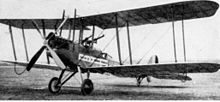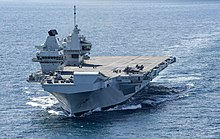
Number 5 Squadron was a squadron of the Royal Air Force. It most recently operated the Raytheon Sentinel R1 Airborne STand-Off Radar (ASTOR) aircraft from RAF Waddington, Lincolnshire, between April 2004 until March 2021.

No. 1435 Flight is a Typhoon FGR. 4 unit of the Royal Air Force, based at RAF Mount Pleasant, providing air defence for the Falkland Islands, South Georgia and the South Sandwich Islands. Permanently based in the islands, the aircrew and groundcrew from the UK are cycled through No. 1435 Flight, providing a 365-day, 24-hour alert.
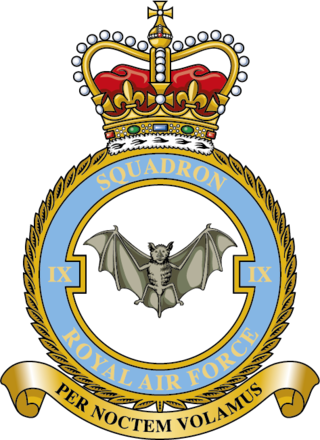
Number 9 Squadron is the oldest dedicated Bomber Squadron of the Royal Air Force. Formed in December 1914, it saw service throughout the First World War, including at the Somme and Passchendaele. During the Second World War, No. IX (B) Squadron was one of two Avro Lancaster units specialising in heavy precision bombing and sank the battleship Tirpitz on 12 November 1944 in Operation Catechism. Between 1962 and April 1982, the squadron flew the Avro Vulcan B.2 as part of the V-Force. In June 1982, it became the first front-line squadron in the world to operate the Panavia Tornado GR.1. In May 1998, No. IX (B) Squadron received the RAF's first Tornado GR.4, which it operated until reequipping with the Eurofighter Typhoon FGR.4 at its present home base of RAF Lossiemouth on 1 April 2019.

Number 6 Squadron of the Royal Air Force operates the Eurofighter Typhoon FGR.4 at RAF Lossiemouth. It was previously equipped with the SEPECAT Jaguar GR.3 in the close air support and tactical reconnaissance roles, and was posted to RAF Coltishall, Norfolk until April 2006, moving to RAF Coningsby until disbanding for the first time in its history on 31 May 2007. The squadron officially reformed as a Typhoon squadron on 6 September 2010. No. 6 Squadron is unique in having two Royal standards, having been awarded its second one by King Abdullah I of Jordan in October 1950 due to its long period of service in the Middle East.

Number 1 Squadron, also known as No. 1 (Fighter) Squadron, is a squadron of the Royal Air Force. It was the first squadron to fly a VTOL aircraft. It currently operates Eurofighter Typhoon aircraft from RAF Lossiemouth.

Number 2 Squadron, also known as No. II Squadron, is the most senior squadron of the Royal Air Force. It is currently equipped with the Eurofighter Typhoon FGR4 at RAF Lossiemouth, Moray, since reforming there on 12 January 2015.

Number 31 Squadron, known as the Goldstars, was a squadron of the Royal Air Force. The Squadron lays claim to being the first military unit to fly in India, where it was based from 1915 to 1947. Throughout the Cold War, No. 31 Squadron was based in West Germany, flying from RAF Laarbruch and RAF Brüggen. Between September 1984 and March 2019, the Goldstars operated the Panavia Tornado GR1/4, initially from RAF Brüggen and after August 2001 from RAF Marham, Norfolk. No. 31 Squadron was disbanded on 14 March 2019 at RAF Marham and will reform in Summer 2023 at RAF Waddington, Lincolnshire, eventually operating the General Atomics Protector RG1 by 2024.

Number 12 Squadron, also known as No. 12 (Bomber) Squadron and occasionally as No. XII Squadron, is a flying squadron of the Royal Air Force (RAF). The squadron reformed in July 2018 as a joint RAF/Qatar Emiri Air Force squadron. It is currently based at RAF Coningsby, Lincolnshire, and operates the Eurofighter Typhoon FGR4, while temporarily integrating Qatari air and ground crews in order to provide training and support as part of the Qatari purchase of 24 Typhoons from the UK.

Number 15 Squadron, sometimes written as No. XV Squadron, was a squadron of the Royal Air Force. It most recently operated the Panavia Tornado GR4 from RAF Lossiemouth as No. XV (Reserve) Squadron. It was the RAF's Operational Conversion Unit for the Tornado GR4 which taught pilots and Weapon Systems Officers (WSO) how to fly the aircraft and what tactics to use to best exploit the performance of their aircraft and its weapons.

Number 43 Squadron, nicknamed the Fighting Cocks, was a Royal Air Force aircraft squadron originally formed in April 1916 as part of the Royal Flying Corps. It saw distinguished service during two world wars, producing numerous "aces". The squadron last operated the Panavia Tornado F3 from RAF Leuchars, Scotland, in the air defence role, until it was disbanded in July 2009.
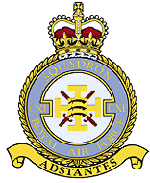
Number 111 (Fighter) Squadron, also known as No. CXI (F) Squadron and nicknamed Treble One, was a squadron of the Royal Air Force. It was formed in 1917 in the Middle East as No. 111 Squadron of the Royal Flying Corps during the reorganisation of the Egyptian Expeditionary Force after General Edmund Allenby took command during the Sinai and Palestine Campaign. The squadron remained in the Middle East after the end of the First World War until 1920 when it was renumbered as No. 14 Squadron.
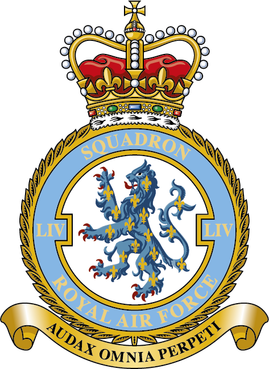
Number 54 Squadron is a squadron of the Royal Air Force based at RAF Waddington, Lincolnshire. On 1 September 2005, it took on the role of Intelligence, Surveillance and Reconnaissance (ISR) Operational Conversion Unit, and is currently responsible for training all RAF crews assigned to the MQ-9A Reaper, Shadow R1/R2, RC-135W Rivet Joint and Poseidon MRA1. It also controls the RAF ISR Warfare School (ISRWS) who run the Qualified Weapons Instructor Intelligence, Surveillance and Reconnaissance and QWI Reaper Courses.

133 Squadron RAF was one of the famous Eagle Squadrons formed from American volunteers serving with the Royal Air Force (RAF) during the Second World War.
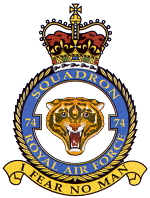
Number 74 Squadron, also known as "Tiger Squadron" from its tiger-head motif, was a squadron of the Royal Air Force. It operated fighter aircraft from 1917 to the 1990s, and then trainers until its disbandment in 2000. It was the Royal Air Force's member of the NATO Tiger Association from 1961 until the squadron's disbandment, it has since been replaced by No. 230 Squadron.

Number 56 Squadron, nicknamed the Firebirds for their ability to always reappear intact regardless of the odds, is one of the oldest and most successful squadrons of the Royal Air Force, with battle honours from many of the significant air campaigns of both the First and Second World Wars.

Number 92 Squadron, also known as No. 92 Squadron and currently as No. 92 Tactics and Training Squadron, of the Royal Air Force is a test and evaluation squadron based at RAF Waddington, Lincolnshire. It was formed as part of the Royal Flying Corps at London Colney as a fighter squadron on 1 September 1917. It deployed to France in July 1918 and saw action for just four months, until the end of the war. During the conflict it flew both air superiority and direct ground support missions. It was disbanded at Eil on 7 August 1919. Reformed on 10 October 1939,at Tangmere Airfield, the unit was supposed to be equipped with medium bombers but in the spring of 1940 it became one of the first RAF units to receive the Supermarine Spitfire, going on to fight in the Battle of Britain.
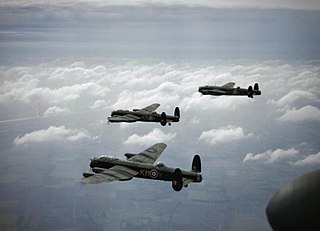
Number 44 (Rhodesia) Squadron was an aviation unit of the Royal Air Force. It was active between 1917 and 1982. For most of its history it served as a heavy bomber squadron.

Royal Air Force Chilbolton or RAF Chilbolton was a Royal Air Force station in Hampshire, England. The airfield was located in Chilbolton approximately 4 miles (6.4 km) south-southeast of Andover, about 62 miles (100 km) southwest of London

The MacRobert Baronetcy, of Douneside in the County of Aberdeen, was a title in the Baronetage of the United Kingdom. It was created on 5 April 1922 for Alexander MacRobert, a self-made millionaire. He was succeeded by his eldest son Alasdair in June of that year. Tragedy struck the family again when Alasdair was killed in a flying accident in 1938, and the title passed to his younger brother Roderic. In May 1941 Roderic was killed in action whilst flying a Hawker Hurricane fighter in the Middle East, and just over a month later on 30 June 1941, the title became extinct when the youngest brother Iain, was also killed in action whilst serving with the Royal Air Force. Their mother, Rachel, Lady MacRobert (1884–1954), gave £25,000 to purchase a Short Stirling bomber, the aircraft was named MacRobert's Reply in memory of her three sons. Lady MacRobert believed that her sons had lived up to the family motto Virtutis Gloria Merces – translated as Honour is the Reward of Bravery. The MacRobert Award, which has been presented every year since 1969 by the Royal Academy of Engineering, is named in honour of Lady MacRobert.
791 Naval Air Squadron was a Naval Air Squadron of the Royal Navy's Fleet Air Arm. It formed as an Air Target Towing Unit, at RNAS Arbroath, in Scotland, in October 1940. It operated various types of aircraft for target towing duties, used to support air gunnery training and practice. The squadron disbanded in December 1944, at Arbroath. It reformed at RNAS Trincomalee, in Sri Lanka, in November 1945, as a Fleet Requirements Unit. The squadron moved to RNAS Sembawang, in Singapore, in December 1945, ferried via HMS Smiter. It also operated a Communications Flight and an Air-Sea Rescue Flight, as well as undertaking anti Mosquito spraying duties. 791 NAS disbanded at Sembawang in June 1947.


